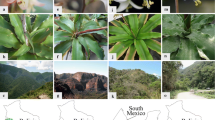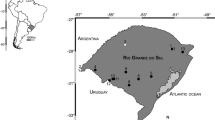Abstract
Genetic variation and breeding system of six populations of Inula racemosa (Asteraceae) from Kashmir Himalaya were assessed using random amplified polymorphic DNA (RAPD) markers and controlled pollination experiments. The 12 RAPD primers applied to 60 individuals generated a total of 116 discernible and reproducible PCR products, of which 51 (43.97%) were polymorphic. The Shannon’s index (Ho) varied with population, ranging from 0.0897 to 1.2217, with an average value of 0.616. The mean diversity at species level was Hsp = 1.217. However, a high level of genetic differentiation among populations was detected based on different measures (Nei’s genetic diversity analysis: Gst = 0.6341; AMOVA analysis: Fst = 0.6822). Using individual plants as the units of replication in controlled pollination experiments, autonomously-selfed and bagged emasculated capitulas set the lowest number of seeds/capitula and differed significantly from geitonogamously selfed capitulas (F = 11.44, p = 0.009), outcrossed capitulas (F = 9.65, p = 0.01), and open-pollinated controls (F = 8.55, p = 0.03) indicating a facultative xenogamy in I. racemosa. Low level of genetic diversity within populations and significant genetic differentiation among populations fit expectations for a rare species, although facultative xenogamy in which Xenogamy predominated and autogamy played an assistant role in I. racemosa may also affect the population genetic structure to some extent.
Similar content being viewed by others
References
Bammi, R.K. and Olmo, H.P., Cytogenetics of Rubus:5. Natural hybridisation between R. procerus P. J. Muell. and R. laciniatus Willd., Evolution, 1966, vol. 20, pp. 20–617.
Barrett, S.C.H. and Kohn, J.R., Genetic and evolutionary consequences of small population size in plants: Implications for conservation, in Genetics and Conservation of Rare Plants, Falk, D.A. and Holsinger, K.E., Eds., New York: Oxford Univ. Press, 1991, pp. 3–30.
Bartish, I., Rumpunen, K., and Nybom, H., Genetic diversity in Chaenomeles (Rosaceae) revealed by RAPD analysis, Plant Syst. Evol., 1999a, vol. 214, pp. 131–145.
Bartish, I.V., Jeppsson, N., and Nybom, H., Population genetic structure in the dioecious pioneer plant species Hippo phaerhamnoides investigated by random amplified polymorphic DNA (RAPD) markers, Mol. Ecol., 1999b, vol. 8, pp. 791–802.
Bussell, J.D., The distribution of random amplified polymorphic DNA (RAPD) diversity amongst populations of Isotoma petraea (Lobeliaceae), Mol. Ecol., 1999, vol. 8, pp. 8–775.
Dafni, A., Pollination Ecology: A Practical Approach, Oxford, UK: Oxford Univ. Press, 1992.
Dawson, I.K. and Powell, W., Genetic variation in the Afromontane tree Prunus africana, an endangered medicinal species, Mol. Ecol., 1999, vol. 8, pp. 8–151.
Dolan, R.W., Patterns in isozyme variation in relation to population size, isolation, and phytogeographic history in royal catchfly (Sileneregia; Caryophyllaceae), Am. J. Bot., 1994, vol. 81, pp. 81–965.
Dupont, Y.L., Evolution of apomixis as a strategy of colonization in the dioecious species Lindera glauca (Lauraceae), Popul. Ecol., 2002, vol. 44, pp. 44–293.
Fischer, M. and Matthies, D., RAPD variation in relation to population size and plant performance in the rare Gentianella germanica, Am. J. Bot., 1998, vol. 85, pp. 85–811.
Frankham, R. and Ralls, K., Inbreeding leads to extinction, Nature, 1998, vol. 392, pp. 392–441.
Hamrick, J.L. and Godt, M.J.W., Allozyme diversity in plant species, in Plant Population Genetics, Breeding and Genetic Resources, Brown, A.H.D., Clegg, M.T., and Kahler, A.L., Eds., Sunderland, MA: Sinauer, 1989, pp. 43–63.
Hamrick, J.L. and Godt, M.J.W., Allozyme diversity in plant species, in Plant Population Genetics, Breeding, and Germplasm Resources, Brown, A.H.D., Clegg, M.T., Kahler, A.L., and Weir, B.S., Eds., Sunderland, MA: Sinauer, 1990, pp. 43–63.
Hamrick, J.L. and Godt, M.J.W., Conservation genetics of endemic plant species, in Conservation Genetics: Case Histories from Nature, Avise, J.C. and Hamrick, J.L., Eds., London: Chapman and Hall, 1996a, pp. 281–304.
Hamrick, J.L. and Godt, M.J.W., Effects of life history traits on genetic diversity in plant species, Phil. Trans. Roy. Soc. London B, 1996b, vol. 351, pp. 1291–1298.
Hogbin, P.M. and Peakall, R., Evaluation of the contribution of genetic research to the management of the endangered plant Zieria prostrata, Conserv. Biol., 1999, vol. 13, pp. 13–514.
Huenneke, L.F., Ecological implications of genetic variation in plant populations, in Genetics and Conservation of Rare Plants, Falk, D.A. and Holsinger, K.H., Eds. New York: Oxford Univ. Press, 1991, pp. 31–44.
Jenczewski, E., Prosperi, J.M., and Ronfort, J., Differentiation between natural and cultivated populations of Medicago sativa (Leguminosae) from Spain: Analysis with random amplified polymorphic DNA (RAPD) markers and comparison to allozymes, Mol. Ecol., 1999, vol. 8, pp. 8–1317.
Kalisz, S.D., Vogler, D., and Hanley, K., Context-dependent autonomous self-fertilization yields reproductive assurance and mixed mating, Nature, 2004, vol. 430, pp. 430–884.
Koltunow, A.M., Johnson, S.D., and Bicknell, R.A., Sexual and apomictic development in Hieracium, Sex Plant Reprod., 1998, vol. 11, pp. 11–213.
Kunin, W.E. and Shmida, A., Plant reproductive traits as a function of local, regional, and global abundance, Conserv. Biol., 1997, vol. 11, pp. 11–183.
Loveless, M.D. and Hamrick, J.L., Ecological determinants of genetic structure in plant populations, Annu. Rev. Ecol. Syst., 1984, vol. 15, pp. 15–65.
Miller, M.P., AMOVA-PREP 1.01: A Program for the Preparation of AMOVA Input Files from Dominant-Markers Raw Data, Flagstaff, AZ: Northern Arizona Univ. Press, 1998.
Nei, M., Estimation of average heterozygosity and genetic distance from a small number of individuals, Genetics, 1978, vol. 89, pp. 89–583.
Nybom, H., Apomixis versus sexuality in blackberries (Rubus subgen. Rubus, Rosaceae), Plant Syst. Evol., 1988, vol. 160, pp. 160–207.
Nybom, H., Evaluation of interspecific crossing experiments in facultative apomict blackberries (Rubus subgen. Rubus) using DNA fingerprinting, Hereditas, 1995, vol. 122, pp. 122–57.
Raijmann, L.E.L., Leeuwen, N.C., Kersten, R., Oostermeijer, J.G.B., Dennijs, H.C.M., and Menken, S.B.J., Genetic variation and outcrossing rate in relation to population size in Gentiana pneumonanthe L., Conserv. Biol., 1994, vol. 8, pp. 8–1014.
Ritland, K., Genetic differentiation, diversity, and inbreeding in the mountain monkey flower (Mimulus caespitosus) of the Washington Cascades, Can. J. Bot., 1989, vol. 67, pp. 67–2017.
Rohlf, F.J., NTSYS, Numerical Taxonomy and Multivariate Analysis System, Setauket, NY: Exeter Ltd., 1994.
Sambrook, J., Fritsch, E.F., and Maniatis, T., Molecular Cloning: A Laboratory Manual, 2nd ed., Cold Spring Harbor, NY: Cold Spring Harbor Laboratory Press, 1989.
Schaal, B.A., Hayworth, D.A., Olsen, K.M., Rauscher, J.T., and Smith, W.A., Phylogeographic studies in plants: Problems and prospects, Mol. Ecol., 1998, vol. 7, pp. 7–465.
Shabir, P.A., Nawchoo, I.A., and Wani, A.A., Floral phenology, secondary pollen presentation and pollination mechanism in Inula racemosa (Angiosperms: Asteraceae), J. Threat. Taxa, 2013, vol. 5, no. 10, pp. 4498–4503
Slatkin, M., Rare alleles as indicators of gene flow, Evolution, 1985, vol. 39, pp. 39–53.
Stanley, R.G. and Linskens, H.F., Viability tests, in Pollen Biology, Biochemistry, and Management, New York: Springer, 1974, pp. 67–86.
Yeh, F.C., Chong, D.K.X., and Yang, R.C., RAPD variation within and among natural populations of trembling aspen (Populus tremuloides) from Alberta, J. Hered., 1995, vol. 86, pp. 86–454.
Yeh, F.C., Yang, R.C., and Boyle, T., POPGENE. Microsoft Windows-based Freeware for Population Genetic Analysis. Release 1.31, Edmonton: Univ. of Alberta Press, 1999.
Young, A., Boyle, T., and Brown, T., The population genetic consequences of habitat fragmentation for plants, Trends Ecol. Evol., 1996, vol. 11, pp. 11–413.
Young, A.S., Change, S.M., and Shartiz, R.R., Reproductive ecology of a federally endangered legume, Baptisia arachnifera, and its more widespread congener, B. lanceolate (Fabaceae), Am. J. Bot., 2007, vol. 94, pp. 94–228.
Zeng, Q., Zhang, D., Gao, Z., and Xing, F., Facultative apomixis in an endangered dioecious species, Woonyoungia septentrionalis (Mangnoliaceae), Acta Bot. Sinica, 2003, vol. 45, no. 11, pp. 1270–1273.
Author information
Authors and Affiliations
Corresponding author
Additional information
The article is published in the original.
Rights and permissions
About this article
Cite this article
Shabir, P.A., Nawchoo, I.A., Wani, A.A. et al. Relative contribution of breeding system and species rarity to genetic differentiation in Inula racemosa Hook. f. (Asteraceae). Russ J Ecol 46, 537–546 (2015). https://doi.org/10.1134/S1067413615060156
Received:
Published:
Issue Date:
DOI: https://doi.org/10.1134/S1067413615060156




